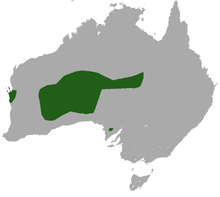Hairy-footed dunnart
| Hairy-footed dunnart[1] | |
|---|---|
| Scientific classification | |
| Kingdom: | Animalia |
| Phylum: | Chordata |
| Class: | Mammalia |
| Infraclass: | Marsupialia |
| Order: | Dasyuromorphia |
| Family: | Dasyuridae |
| Genus: | Sminthopsis |
| Species: | S. hirtipes |
| Binomial name | |
| Sminthopsis hirtipes Thomas, 1898 | |
 | |
| Hairy-footed dunnart range | |
The hairy-footed dunnart (Sminthopsis hirtipes) is a dunnart that has silver hairs on the soles of it hind feet accompanied by long hair on the side of its sole. It is an Australian marsupial similar to the Ooldea dunnart, with its upper body yellow-brown and lower body white in colour. Its total length is 147–180 mm; its average body length is 72–85 mm with a tail of 75–95 mm. Its ear length is 15 mm. This dasyurid weighs between 13 and 19 grams. Its tail is thin and pinkish white, can be thickened at the base.
Distribution and habitat
This species inhabits 3 distinct areas; around Monkey Mia Bay and Kilbarri in Western Australia, a large area where the border of South Australia, Northern Territory and Western Australia converge and a small area between the Northern Territory and Queensland border 100 km north of the South Australian border. Its habitat includes arid and semi-arid woodlands, heath, savannah grasslands.
Social organisation and breeding
The hairy-footed dunnart lives in burrows built by spiders, bull ants and other similar burrowing type species. Not much is known about the breeding cycle but the young are in the pouch by October and juveniles emerge by late April.
Diet
Its typical diet includes mainly small reptiles and arthropods.
References
- ↑ Groves, C.P. (2005). Wilson, D.E.; Reeder, D.M., eds. Mammal Species of the World: A Taxonomic and Geographic Reference (3rd ed.). Baltimore: Johns Hopkins University Press. p. 36. ISBN 0-801-88221-4. OCLC 62265494.
- ↑ McKenzie, N. & Dickman, C. (2008). "Sminthopsis hirtipes". IUCN Red List of Threatened Species. Version 2008. International Union for Conservation of Nature. Retrieved 28 December 2008.
- Menkhorst, P.; Knight, F. (2001). A field Guide to the Mammals of Australia. Oxford Press. ISBN 0-19-550870-X.
